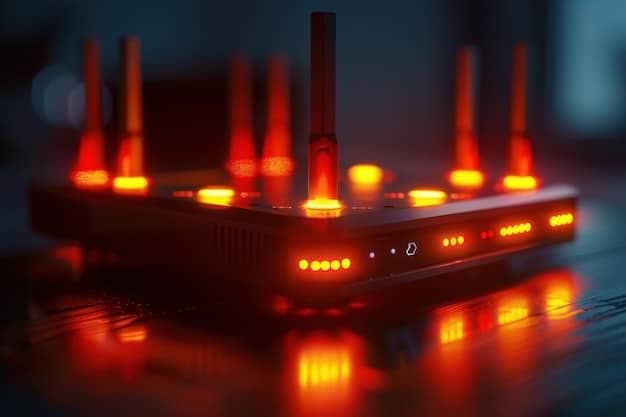Protect all your devices: how to use a VPN on your router

Setting up a VPN directly on your router provides comprehensive network security by encrypting all traffic from every connected device, eliminating the need to install VPN software on each individual gadget.
In an increasingly interconnected world, safeguarding your digital footprint has become paramount. With a myriad of devices populating our homes and offices, from smartphones and laptops to smart TVs and IoT gadgets, ensuring their collective security can seem like a daunting task. Imagine a single solution that shields every device on your network, effortlessly and consistently. This is precisely what you achieve when you learn how to use a VPN on your router to protect all your devices at once, offering a robust, all-encompassing layer of privacy and security without the hassle of individual installations.
Understanding the benefits of a router VPN
Using a VPN directly on your router offers a multitude of advantages that transcend convenience, providing a holistic approach to online security and privacy. When your router is configured with a VPN, every device that connects to it automatically inherits the VPN’s protection, regardless of its operating system or whether it even supports VPN software directly. This includes smart TVs, gaming consoles, smart home devices, and even guest devices that connect to your Wi-Fi. It’s a set-and-forget solution that simplifies your digital life significantly.
Uninterrupted protection on every device
Unlike installing VPN clients on individual devices, a router VPN ensures constant protection for all connected gadgets. This means you no longer have to worry about forgetting to turn on the VPN on your laptop or mobile phone. Once configured, the VPN on your router is always active, encrypting all incoming and outgoing network traffic. This provides a consistent shield against snooping, data interception, and geo-restrictions, creating a truly private and secure home network environment. Think about the multitude of devices in a modern home: phones, tablets, smart speakers, security cameras, and even smart refrigerators. Manually configuring each one, if even possible, would be a monumental task. A router VPN streamlines this, bringing blanket protection instantly.
* Always-on security: Once set up, your VPN is continuously active, protecting every device without manual intervention.
* Device agnostic: Protects devices that typically don’t support VPN apps, like smart TVs, gaming consoles, and IoT devices.
* Simplified management: Manage VPN settings from a single point – your router – rather than individual devices.
A router VPN also ensures that your connection speeds are more consistent across devices. While individual VPN apps might introduce slight variations depending on the device’s processing power, a router VPN centralizes this process, potentially leading to a more uniform experience. Furthermore, it helps bypass ISP throttling, a common practice where internet service providers deliberately slow down your connection based on your online activities, offering a smoother, unrestricted browsing experience. The robust encryption methods employed by reputable VPN providers, when deployed at the router level, render your online activities unreadable to third parties, including your ISP, government agencies, and potential cybercriminals. This heightened level of privacy extends to every member of your household, ensuring that everyone’s online presence is secure.
Pre-installation checklist: what you need
Before embarking on the journey of setting up a VPN on your router, it’s crucial to gather the necessary tools and information. A little preparation goes a long way in ensuring a smooth and successful installation process. The primary requirement is a compatible router, as not all routers support VPN functionality straight out of the box. Many modern routers, especially those from reputable brands, come with built-in VPN client support. If yours doesn’t, you might need to flash it with custom firmware like DD-WRT or OpenWRT, which unlocks advanced functionalities, including VPN client capabilities.
Checking router compatibility and firmware
First, identify your router’s make and model. Then, check its specifications online or consult your VPN provider’s website for a list of compatible routers. Some VPN services even sell pre-flashed routers that are ready to use with their service. If your router isn’t natively supported, flashing custom firmware can be a viable option, but it requires a degree of technical expertise and carries a small risk of “bricking” your device if done incorrectly. Always follow detailed, specific instructions for your router model when flashing firmware.
* VPN-compatible router: Essential for native VPN support.
* Custom firmware (optional): DD-WRT, OpenWRT, or Tomato can extend router capabilities.
* Reliable VPN subscription: Choose a provider that actively supports router configurations.
Beyond router compatibility, you’ll need an active subscription with a reputable VPN service. Not all VPN providers offer comprehensive support for router setups, so it’s wise to choose one known for its router compatibility, such as ExpressVPN, NordVPN, or Surfshark. These providers typically offer detailed guides and dedicated customer support for router configurations. You will also need your VPN account login credentials and
specific configurations provided by your VPN service, such as server addresses, protocols (OpenVPN, IKEv2, etc.), and encryption keys. It’s also advisable to have a computer with an Ethernet cable connection to your router, as setting up a VPN often requires direct access to the router’s administrative interface, which is more stable with a wired connection.
Choosing the right VPN provider for routers
Selecting the appropriate VPN provider is a critical step in ensuring a seamless and secure router VPN experience. Not all VPN services are created equal, especially when it comes to supporting router-level installations. A good VPN provider for routers will offer robust encryption, a wide network of servers, and, most importantly, clear, comprehensive guides and dedicated support for various router models and firmware types. The ease of setup and ongoing maintenance largely depends on the quality of your chosen VPN service.
Key features to look for in a router VPN
When evaluating VPN providers for router compatibility, prioritize those that offer detailed setup tutorials for different router brands and firmware (e.g., DD-WRT, OpenWRT). Many top-tier VPNs provide custom firmware versions or specific configuration files that simplify the installation process. Look for providers that offer OpenVPN support, as this is one of the most widely supported and secure protocols for router VPNs. Additionally, consider the VPN’s server network size and distribution. A larger network typically means more options for bypassing geo-restrictions and finding faster connections.
* Dedicated router support: Look for extensive setup guides and customer service for router configurations.
* OpenVPN protocol: A secure and widely compatible choice for routers.
* Broad server network: Ensures reliable speeds and diverse server locations.
Another crucial factor is the VPN’s logging policy. Choose a provider with a strict no-logs policy to ensure your online activities remain private, even when routed through your VPN-configured router. Features like a kill switch—though less common at the router level—and DNS leak protection are also beneficial for maintaining anonymity and security. Some providers even offer split tunneling, which allows you to select which devices or applications use the VPN and which connect directly to the internet, providing flexibility in managing your network traffic. Speed and reliability are also paramount; a sluggish VPN will negate the benefits of network-wide protection. Read reviews and consider free trials if available to test performance before committing to a long-term subscription.

Step-by-step installation guides
The process of installing a VPN on your router varies significantly depending on your router’s brand, model, and whether it supports VPN clients natively or requires custom firmware. While the exact steps might differ, the general principles remain consistent. It’s essential to follow your VPN provider’s specific instructions for your router model, as deviations can lead to connectivity issues or even brick your device. Always start by backing up your router’s current configuration to ensure you can revert if anything goes wrong.
Setting up a VPN on compatible routers (native support)
For routers with native VPN client support, the setup usually involves accessing the router’s web-based administration interface. This typically means opening a web browser and entering your router’s IP address (often 192.168.1.1 or 192.168.0.1). Once logged in, navigate to the VPN section, which might be labeled “VPN Client,” “OpenVPN,” or “Advanced Settings.” Here, you’ll usually be prompted to upload an OpenVPN configuration file (.ovpn) provided by your VPN service. After uploading, enter your VPN username and password, then apply the settings. Your router should then establish a connection to the VPN server, and all connected devices will be protected.
* Access router interface: Log in via a web browser using the router’s IP address.
* Locate VPN settings: Find the “VPN Client” or similar section.
* Upload configuration: Import the .ovpn file from your VPN provider and enter credentials.
Flashing custom firmware (DD-WRT, OpenWRT)
If your router doesn’t support VPN clients natively, flashing custom firmware like DD-WRT or OpenWRT is an alternative. This process is more complex and carries risks, so proceed with caution. First, ensure your router model is supported by the custom firmware. Download the correct firmware file from the official DD-WRT or OpenWRT website. Then, access your router’s administrative interface and look for a “Firmware Upgrade” or “Router Upgrade” section. Upload the custom firmware file and wait for the process to complete. Do NOT interrupt the router during this process. Once the new firmware is installed, the router will reboot, and you can then access its new interface, which will have a dedicated VPN client section where you can typically upload OpenVPN configuration files and enter your VPN credentials, similar to native support.
Configuring VPN settings and features
Once your VPN is installed on the router, the next crucial step is to fine-tune its settings and leverage available features to optimize performance and security. This involves more than just connecting to a server; it’s about tailoring the VPN and network interaction to your specific needs. Understanding parameters like server selection, protocol choice, and additional security features ensures that you’re maximizing the benefits of your router VPN.
Optimizing server selection and protocols
The choice of VPN server significantly impacts your internet speed and access to geo-restricted content. To minimize latency and maximize speed, select a server geographically close to your location. If you’re trying to access content from a specific region, choose a server in that country. Most VPN-enabled routers allow you to switch between servers. Regarding protocols, OpenVPN is generally recommended for its balance of security and performance, but some routers might also support IKEv2 or L2TP/IPsec. Experimenting with different protocols might yield better results depending on your ISP and network conditions.
* Proximity for speed: Choose servers closest to your physical location.
* Geo-unblocking: Select servers in the desired country for content access.
* Protocol choice: OpenVPN is standard, but try others if available for performance.
Advanced features: split tunneling and kill switch
Some advanced router firmware and VPN providers offer features like split tunneling, which allows certain devices or applications to bypass the VPN tunnel while others remain protected. This is useful for services that might block VPN usage (like some banking apps) or for local network access. While a traditional kill switch, which disconnects your internet if the VPN drops, is common in client software, router VPNs achieve a similar effect by simply not routing traffic if the VPN connection isn’t established. Some custom firmware might offer more granular control over network routing policies, allowing you to configure fail-safes in case the VPN connection falters, ensuring no unencrypted traffic ever leaves your network. Regularly checking your router’s VPN status and performing DNS leak tests are good practices to ensure constant protection.
Maintaining and troubleshooting your router VPN
Even after successful installation, maintaining and occasionally troubleshooting your router VPN is important to ensure continuous, optimal performance. Like any piece of technology, router VPNs can encounter issues, ranging from slow speeds to dropped connections. Regular monitoring and knowing how to address common problems will significantly enhance your experience with network-wide security.
Regular checks and updates
Periodically check your router’s VPN status within its administrative interface to confirm it’s still connected and functioning. Some routers offer logs that can provide insights into connection stability. It’s also crucial to keep your router’s firmware updated. Router manufacturers and custom firmware developers frequently release updates that include security patches, bug fixes, and performance improvements. Similarly, ensure your VPN provider’s configurations (e.g., server details, certificates) are current, as they occasionally update these to enhance security or introduce new servers.
* Monitor VPN status: Confirm active connection via router interface.
* Update firmware: Install the latest router firmware versions.
* Keep VPN configs current: Ensure you use the most recent server details from your VPN provider.
Common issues and solutions
One of the most frequent issues is slow internet speed. This can often be resolved by switching to a different VPN server, ideally one closer to your physical location or less congested. If speeds remain low, try changing the VPN protocol or checking your internet service provider’s (ISP) connection quality directly. Connection drops can sometimes be due to unstable Wi-Fi signals or an overloaded router; rebooting your router frequently resolves this. If the VPN fails to connect, double-check your VPN credentials, ensuring the username, password, and configuration files are correct. For persistent issues, consult your VPN provider’s customer support. They often have dedicated troubleshooting guides or live chat support that can walk you through complex problems specific to their service and your router model.

Advanced uses and further considerations
Beyond basic security, a VPN on your router unlocks a range of advanced uses that can significantly enhance your digital lifestyle. It’s not just about privacy anymore; it’s about controlling your network’s identity and capabilities. Thinking beyond the standard setup reveals further possibilities for leveraging this powerful tool, from managing multiple VPN connections to integrating with other network services.
Network customization and multiple VPNs
For users who require different VPN connections for various purposes or regions, some advanced routers and custom firmware allow for the configuration of multiple VPN clients. This means you could assign specific devices or even specific applications to route their traffic through different VPN servers. For instance, your streaming devices could connect via a UK server, while your gaming console uses a US server, all managed from the router. This level of granular control offers unparalleled flexibility. It’s a subtle but significant upgrade, especially for households with diverse digital needs. The sophisticated network management this provides ensures every user and device has optimal performance and access tailored to their activities.
* Multi-VPN setup: Assign different VPNs to different devices or traffic types.
* Policy-based routing: Define specific rules for how traffic is routed, with or without VPN.
* IoT segmentation: Isolate smart home devices on their own VPN connection for enhanced security.
Integrating with smart home and IoT devices
One of the most compelling advantages of a router VPN is its ability to protect smart home and IoT (Internet of Things) devices. Many of these devices, such as smart light bulbs, thermostats, and security cameras, lack built-in VPN support and can be vulnerable gateways for cyberattacks. When connected to a VPN-enabled router, all their traffic is automatically encrypted and routed through the VPN tunnel, significantly enhancing their security posture. This not only protects your devices from external threats but also prevents manufacturers or third parties from collecting potentially sensitive data transmitted by these devices. For the privacy-conscious, this blanket protection for smart devices is an invaluable benefit, offering peace of mind in an increasingly connected home. Always ensure your smart devices are on their latest firmware and connected securely.
| Key Point | Brief Description |
|---|---|
| 🛡️ Network-Wide Protection | Secure all devices, including smart TVs and IoT, with a single VPN setup on your router. |
| ✔️ Automated Security | Enjoy always-on VPN protection without having to activate it on individual devices. |
| ⚙️ Compatibility Check | Verify router compatibility or consider custom firmware like DD-WRT. |
| 🚀 Optimized Performance | Select close servers and suitable protocols (OpenVPN) for best speed. |
Frequently asked questions about router VPNs
Installing a VPN directly on your router protects every device connected to your network, including those that don’t natively support VPN apps like smart TVs, gaming consoles, and IoT devices. It provides an always-on layer of security and privacy for your entire household, simplifying management and ensuring consistent protection without individual installations.
Yes, a VPN can introduce some speed reduction due to encryption overhead and server distance. However, the impact varies based on your router’s processing power, the VPN protocol used, and the chosen VPN server’s proximity and load. Selecting a high-quality VPN service and a nearby server can minimize speed loss.
You typically need a router that supports VPN client functionality. Many newer routers from brands like ASUS, Netgear, or Linksys have native support. If yours doesn’t, you might need to flash it with custom firmware like DD-WRT, OpenWRT, or Tomato, which enable VPN client capabilities through software modifications.
The difficulty varies. For routers with native VPN client support, it’s generally straightforward, involving uploading a configuration file and entering credentials. Flashing custom firmware is more complex and carries some risk, requiring careful adherence to specific instructions for your router model. Reputable VPN providers offer detailed guides to assist with the process.
Yes, some advanced router firmware and VPN providers offer a feature called split tunneling. This allows you to configure specific devices or applications to bypass the VPN and connect directly to the internet, while others remain securely routed through the VPN. This provides flexibility for services that may block VPN traffic.
Conclusion
Embracing the power of a router VPN is more than just an upgrade; it’s a fundamental shift towards a comprehensively secure and private digital existence for everyone and everything connected to your home network. By centralizing your cybersecurity efforts, you not only simplify protection across a myriad of devices but also unlock a realm of advanced network control and anonymity that individual VPN applications simply cannot offer. From safeguarding vulnerable IoT gadgets to bypassing geo-restrictions for your entire household, a router VPN stands as an intelligent, robust, and future-proof solution for navigating the complexities of the modern internet with confidence and peace of mind.





